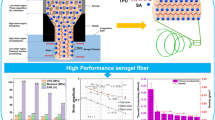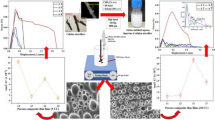Abstract
Natural fibers in micro and nano scales may be a potential alternative for man-made fibers because of the comparable mechanical properties to those of glass, carbon, and aramid fibers. Cellulose fibril and fibril aggregate are generally prepared by physical treatments, e.g., high-pressure homogenizer, or chemical treatments, e.g., acid hydrolysis. In this study, fibril aggregates were generated from a regenerated cellulose fiber by a novel mechanical treatment. The geometrical characteristics of the fibers and the fibril aggregates were investigated using scanning electron microscopy (SEM) and polarized light microscopy (PLM), and its crystallinity was investigated by wide angle X-ray diffraction (WAXD). The degree of fibrillation of the fibers was indirectly evaluated by water retention value (WRV). Nano-biocomposites reinforced with fibril aggregates were prepared by film casting and compression molding and evaluated by tensile test. The morphological characteristics of the nanocomposites were investigated with SEM and PLM. As reference, commercial microfibrillated cellulose was also used to reinforce biodegradable polymer.













Similar content being viewed by others
Abbreviations
- MFC:
-
Microfibrillated cellulose
- PLM:
-
Polarized light microscopy
- PP:
-
Polypropylene
- PVA:
-
Poly vinyl alcohol
- SEM:
-
Scanning electron microscopy
- WAXD:
-
Wide angle X-ray diffraction
- WRV:
-
Water retention value
References
ASTM D (1708–2002) Standard test method for tensile properties of plastics by use of microtensile specimens
Beck-Candanedo S, Roman M, Gray DG (2005) Effect of reaction conditions on the properties and behavior of wood cellulose nanocrystal suspensions. Biomacromolecules 6(2):1048–1054
Berglund L (2005) Cellulose-based nanocomposites. In: Mohanty AK, Misra M, Drzal L (eds) Natural fibers, biopolymers, and biocomposites. Taylor & Francis, pp 807–832
Bondeson D, Mathew A, Oksman K (2006) Optimization of the isolation of nanocrystals from microcrystalline cellulose by acid hydrolysis. Cellulose 13(2):171–180
Chakraborty A, Sain M, Kortschot M (2005) Cellulose microfibrils: a novel method of preparation using high shear refining and cryocrushing. Holzforschung 59(1):102–107
Chakraborty A, Sain M, Kortschot M (2006a) Cellulose microfibers as reinforcing agents for structural materials, cellulose nanocomposites: processing, characterization, and properties. Acs Symposium Series, pp 169–186
Chakraborty A, Sain M, Kortschot M (2006b) Reinforcing potential of wood pulp-derived microfibres in a PVA matrix. Holzforschung 60(1):53–58
Cheng Q, Wang S, Zhou D, Zhang Y, Rials T (2007) Lyocell-derived cellulose fibril and its biodegradable nanocomposite. J Nan**g For Univ 31(4):21–26
Choi YJ, Simonsen J (2006) Cellulose nanocrystal-filled carboxymethyl cellulose nanocomposites. J Nanosci Nanotechnol 6(3):633–639
Dufresne A, Cavaille JY, Vignon MR (1997) Mechanical behavior of sheets prepared from sugar beet cellulose microfibrils. J Appl Polym Sci 64(6):1185–1194
Dufresne A, Dupeyre D, Vignon MR (2000) Cellulose microfibrils from potato tuber cells: processing and characterization of starch-cellulose microfibril composites. J Appl Polym Sci 76(14):2080–2092
Eichhorn SJ, Young RJ (2001) The Young’s modulus of a microcrystalline cellulose. Cellulose 8(3):197–207
Favier V, Canova GR, Cavaille JY, Chanzy H, Dufresne A, Gauthier C (1995) Nanocomposite materials from latex and cellulose whiskers. Polym Adv Technol 6(5):351–355
Ganster J, Fink HP (2006) Novel cellulose fibre reinforced thermoplastic materials. Cellulose 13(3):271–280
George J, Sreekala MS, Thomas S (2001) A review on interface modification and characterization of natural fiber reinforced plastic composites. Polym Eng Sci 41(9):1471–1485
Hajji P, Cavaille JY, Favier V, Gauthier C, Vigier G (1996) Tensile behavior of nanocomposites from latex and cellulose whiskers. Polym Compos 17(4):612–619
Herrick FW, Casebier RL, Hamilton JK, Sandberg KR (1983) Microfibrillated cellulose: morphology and accessibility. J Appl Polym Sci: Appl Polym Symp 37:797–813
Lima MMD, Borsali R (2004) Rodlike cellulose microcrystals: structure, properties, and applications. Macromol Rapid Commun 25(7):771–787
Mathew AP, Oksman K, Sain M (2005) Mechanical properties of biodegradable composites from poly lactic acid (PLA) and microcrystalline cellulose (MCC). J Appl Polym Sci 97(5):2014–2025
Nakagaito AN, Yano H (2005) Novel high-strength biocomposites based on microfibrillated cellulose having nano-order-unit web-like network structure. Appl Phys a-Mater Sci Process 80(1):155–159
Peng SJ, Shao HL, Hu XC (2003) Lyocell fibers as the precursor of carbon fibers. J Appl Polym Sci 90(7):1941–1947
Sakurada I, Nukushina Y, Ito T (1962) Experimental determination of elastic modulus of crystalline regions in oriented polymers. J Polym Sci 57(165):651–660
Samir M, Alloin F, Sanchez JY, Dufresne A (2004) Cross-linked nanocomposite polymer electrolytes reinforced with cellulose whiskers. Macromolecules 37(13):4839–4844
Sturcova A, Davies GR, Eichhorn SJ (2005) Elastic modulus and stress-transfer properties of tunicate cellulose whiskers. Biomacromolecules 6(2):1055–1061
Taniguchi T (1996) Microfibrillation of natural fibrous materials. J Soc Mat Sci Japan 45(4):472–473
Thygesen A, Oddershede J, Lilholt H, Thomsen AB, Stahl K (2005) On the determination of crystallinity and cellulose content in plant fibres. Cellulose 12(6):563–576
Turbak AF, Snyder FW, Sandberg KR (1983) Microfibrilated cellulose, a new cellulose product: properties, uses, and commercial potential. J Appl Polym Sci: Appl Polym Symp 37:815–827
Wang S, Cheng Q (2007) A novel method to isolate fibrils from cellulose fibers by high intensity ultrasonication (in preparation)
Woodings C (2000) Regenerated cellulose fibers. Woodhead publishing limited, Cambridge, England
Zimmermann T, Pohler E, Geiger T (2004) Cellulose fibrils for polymer reinforcement. Adv Eng Mater 6(9):754–761
Acknowledgments
The authors thank Dr. Joseph Spruiell of Department of Material Science and Engineering, UT, for his help of WAXD; Dr. John R. Dunlap of the Division of Biology, UT, for his valuable assistances in SEM experiments; Lenzing company for their supply of Lyocell fibers; FiberVisions, Georgia for their supply of PP fibers; and USDA Wood Utilization Research Program and Tennessee Agricultural Experiment Station project # 96 for funding.
Author information
Authors and Affiliations
Corresponding author
Rights and permissions
About this article
Cite this article
Cheng, Q., Wang, S., Rials, T.G. et al. Physical and mechanical properties of polyvinyl alcohol and polypropylene composite materials reinforced with fibril aggregates isolated from regenerated cellulose fibers. Cellulose 14, 593–602 (2007). https://doi.org/10.1007/s10570-007-9141-0
Received:
Accepted:
Published:
Issue Date:
DOI: https://doi.org/10.1007/s10570-007-9141-0




